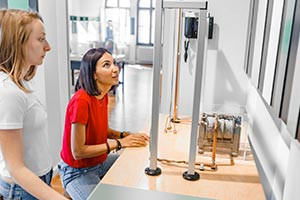This course covers two fundamental aspects of physics: measurement and motion. A unit of measurement is a standardized quantity of physical property used as a factor to express occurring quantities of that property. Units of measurement were among the earliest tools invented by humans. The definition, agreement, and practical use of units of measurement have played a crucial role in human endeavor from early ages up to the present. They are important because without them, it would be extremely difficult for scientists to express and compare measured values in a meaningful way. The measurements of physical quantities are expressed in terms of units, which are standardized values. For example, the length of a race, which is a physical quantity, can be expressed in metres (for sprinters) or kilometres (for long-distance runners). You will learn about unit conversions and the guidelines for good graphing techniques.
The course then introduces you to vector and scalar quantities. Mathematics and science developed as ways of understanding and describing the world around us. A lot of mathematical quantities are used in physics to explain concepts clearly, including force, speed, velocity, and work. These are often described as being scalar or vector quantities. Scalar and vector quantities are differentiated depending on their definition. You will also learn about the resultant of two vectors that are collinear and at right angles. Some numerical statements are exact: for example, 2 + 2 = 4. However, all measurements have some degree of uncertainty that may come from a variety of sources. The process of evaluating this uncertainty associated with a measurement result is called uncertainty analysis or error analysis. You will learn about the different types of errors and how to measure them.
Then, you will be introduced to the study of motion. In physics, motion is the phenomenon in which an object changes its position over time. Motion is mathematically described in terms of displacement, distance, velocity, acceleration, speed, and time. The motion of a body or object is observed by attaching a frame of reference to an observer. Measuring the change in position of the body relative to that frame with a change in time. The branch of physics describing the motion of objects without reference to its cause is kinematics. The branch studying forces and their effect on motion is known as dynamics. You will learn about different aspects of motion and its graphical analysis. Next, the course analyzes acceleration. An often confused quantity, acceleration has a much different meaning from what is implied by sports announcers and other people. You will learn about the different types of acceleration and how to calculate them. So, register for this course today and begin your next learning journey in physics!
What You Will Learn In This Free Course
- Distinguish between fundamental and...
- Recall the SI units of measurement...
- Label quantities with the appropria...
- Discuss the importance of a system ...
- Distinguish between fundamental and derived units
- Recall the SI units of measurement
- Label quantities with the appropriate units
- Discuss the importance of a system of units for physical meaning
- Distinguish between distance and displacement
- Describe motion in a straight line in terms of displacement, velocity, and acceleration/li>
- Identify the various types of acceleration
- Recall the graphical analysis of motion
- Explain the position-time graph
View All Learning Outcomes View Less All Alison courses are free to enrol study and complete. To successfully complete this certificate course and become an Alison Graduate, you need to achieve 80% or higher in each course assessment. Once you have completed this certificate course, you have the option to acquire an official certificate, which is a great way to share your achievement with the world.
Your Alison certificate is:
- Ideal for sharing with potential employers
- Great for your CV, professional social media profiles and job applications.
- An indication of your commitment to continuously learn, upskill & achieve high results.
- An incentive for you to continue empowering yourself through lifelong learning.
Alison offers 3 types of certificates for completed certificate courses:
- Digital certificate: a downloadable certificate in PDF format immediately available to you when you complete your purchase.
- certificate: a physical version of your officially branded and security-marked certificate
All certificates are available to purchase through the Alison Shop. For more information on purchasing Alison certificate, please visit our FAQs. If you decide not to purchase your Alison certificate, you can still demonstrate your achievement by sharing your Learner Record or Learner Achievement Verification, both of which are accessible from your Account Settings.





















 CPD Accredited
CPD Accredited
 Knowledge & Skills You Will Learn
Knowledge & Skills You Will Learn
 $47,798
$47,798






